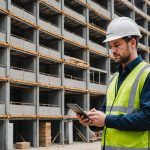Technology Integration
Incorporating advanced technology integration in construction is pivotal for driving innovation. Modern construction processes are increasingly reliant on smart building technology such as the Internet of Things (IoT) and Artificial Intelligence (AI). IoT enables connectivity between devices and systems, optimising functionalities like energy consumption and security monitoring. AI, on the other hand, enhances decision-making with data-driven insights, improving efficiency and forecasting potential issues.
Construction innovation through smart technologies isn’t just a trend; it’s reshaping the industry. These technologies facilitate precise resource management and streamline operations, reducing costs and environmental impact.
Additional reading : Key factors propelling uk real estate companies to embrace proptech innovations
Key examples of successful technology integration include office complexes equipped with sensor systems to monitor and adjust lighting and temperature automatically, vastly improving energy efficiency. Residential projects are also adopting integrated security systems, providing real-time alerts and access control.
The importance of embracing these technologies cannot be overstated, as they offer competitive advantages and align with the evolving demands for smarter, sustainable buildings. Construction companies investing in technology integration not only enhance operational capabilities but also boost their market appeal by showcasing commitment to innovation and environmentally responsible practices.
Also to read : Revolutionizing menus: key ai tactics for uk restaurants to elevate culinary innovation
Sustainability Practices
In the realm of modern construction, sustainability has emerged as a pivotal factor. The importance of sustainable construction cannot be overstated, as it aligns with global efforts to minimize environmental impact. Sustainable practices integrate seamlessly with smart building technology, focusing on energy efficiency and the use of green building materials.
Key strategies for integrating sustainable practices into construction projects include the adoption of energy-efficient systems and the use of eco-friendly materials. These practices are not only beneficial for the environment but also enhance the overall value of buildings. For instance, smart technologies such as IoT can optimise heating, ventilation, and air conditioning systems, significantly reducing energy consumption and costs.
Examples of sustainable materials in use today include recycled steel, reclaimed wood, and low-VOC paints, all contributing to healthier indoor environments and resource conservation. Furthermore, initiatives like green roofs and solar panel installations add to the energy efficiency and sustainability of smart buildings.
By prioritising energy efficiency and eco-friendly solutions, construction firms not only meet the demands of sustainability-conscious customers but also adhere to regulatory compliance. Sustainable practices in smart buildings offer a compelling model for responsible development in the construction industry.
Cost Analysis
Implementing smart building technology in construction necessitates a comprehensive evaluation of construction costs. These costs encompass initial investments in IoT devices, AI systems, and integration technologies. Budget management becomes crucial to ensure projects remain financially viable while incorporating innovative solutions.
A financial analysis reveals that while initial outlays may be substantial, the long-term savings are compelling. Efficiencies gained through predictive maintenance, energy management, and resource optimisation lead to lower operational costs. For example, AI-driven systems can dramatically reduce energy consumption by optimising heating and cooling operations, offsetting installation expenses.
Key financial models can assist firms in budget management. One approach is to integrate phased investments, allowing for gradual incorporation of new technologies while monitoring returns. Additionally, government incentives and grants can alleviate upfront costs, promoting sustainable and innovative construction practices.
The integration of advanced technologies in construction is not just a technical decision but a financial planning strategy. Construction companies must assess both short-term expenditures and long-term benefits, ensuring that the adoption of smart building solutions aligns with their financial goals and market positioning. In this way, they can leverage technology to enhance competitiveness while maintaining economic diligence.
Workforce Training
Incorporating smart building technology within construction requires comprehensive workforce training. As the industry evolves, it’s vital for staff to possess enhanced skills to manage and operate these innovative systems effectively. Workforce development initiatives are essential to bridge the gap between traditional construction knowledge and the requirements of modern technology integration.
Training Programs for Skill Enhancement
To address these needs, dedicated training programs are being developed. These programs focus on the practical application of IoT and AI, ensuring that employees gain hands-on experience. By learning how to install, maintain, and troubleshoot these systems, workers can contribute to smoother project execution and efficiency enhancements.
Impact on Project Success
A well-trained workforce significantly impacts the success of construction innovation projects. Empowered employees feel confident in utilizing advanced technologies, leading to improved problem-solving capabilities and operational efficiencies. Moreover, continuous skill enhancement fosters a culture of innovation, encouraging staff to explore new solutions and approaches.
Ultimately, prioritizing workforce training in smart technologies ensures that construction firms remain competitive and capable of meeting the demands of smart building technology adoption. Developing strong training programs not only enhances individual competencies but also contributes to the overall growth and success of construction projects.
Regulatory Compliance
Incorporating smart building technology within the construction industry necessitates an understanding of relevant UK regulations. Adhering to these building regulations ensures that firms meet the required compliance standards. Safety guidelines and environmental criteria are paramount to not only fulfilling legal obligations but also ensuring the longevity and sustainability of smart buildings.
Importance of Legal Compliance
Compliance with legal standards in construction acts as the backbone of project execution. Firms must navigate regulations such as those set by the Building Regulations 2010 and other related statutes focused on safety, energy efficiency, and sustainability. Non-compliance can lead to significant financial penalties, project delays, and reputational damage.
Strategies for Ensuring Compliance
- Regular updates: Consistently staying informed about changes in building codes and regulations.
- Consultation: Engaging with regulatory bodies and legal experts to develop comprehensive compliance strategies.
- Documentation: Maintaining meticulous records proving adherence to safety and environmental standards.
By proactively embracing these strategies, construction firms can mitigate risks associated with non-compliance. This not only secures legal integrity but also enhances a firm’s reputation as a leader in responsible and innovative construction practices.
Case Studies and Industry Trends
The construction industry’s evolution is epitomised by notable case studies showcasing effective smart building integration. These examples provide compelling industry insights and highlight the sector’s dynamic nature. By examining such instances, firms can glean valuable lessons that inform future construction trends.
A standout case study is the Edge Building in Amsterdam, often lauded as one of the most sustainable office buildings globally. Utilizing smart building technology, it integrates thousands of sensors that monitor energy use, occupancy, and temperature, driving significant efficiency gains. This project’s success illustrates how technology meets sustainability.
Industry insights also reveal a growing trend towards modular construction. This method–paralleled by cutting-edge smart solutions–aligns with demand for rapid urbanization and sustainable practices. With prefabrication and IoT monitoring, construction times and waste are significantly reduced.
Lessons from these projects underscore three key takeaways: effective technology integration facilitates environmental and cost benefits, modular approaches enhance speed and sustainability, and real-time data usage is crucial. To remain competitive, construction firms must adapt, incorporating these trends into strategies for future developments. Understanding these patterns will be crucial for staying ahead in a rapidly changing industry.
Challenges and Actionable Strategies
Adopting smart building technology presents several implementation challenges for construction firms. A primary hurdle is the integration of new systems with existing infrastructure, which can disrupt current operations. Additionally, the initial costs and complexity of technology upgrades often exceed forecasts, straining budgets. Lack of adequate workforce training is another significant barrier, as staff may not possess the necessary skills to effectively use advanced systems.
To address these challenges, firms must employ strategic solutions. Initiating phased adoption of technology can mitigate operational disruptions, allowing systems to be gradually integrated. Comprehensive risk assessments are essential, enabling firms to anticipate potential problems and develop contingency plans. Emphasising workforce development through tailored training programs is crucial to ensure that staff can manage and operate new technologies efficiently.
Risk management strategies are vital for successful project implementation. These include establishing clear project goals, timelines, and communication channels to enhance collaboration among stakeholders. Furthermore, engaging with technology vendors for continuous support and updates ensures systems operate smoothly. By adopting these measures, construction companies can navigate challenges and enhance their capacity to implement smart building technologies effectively.











